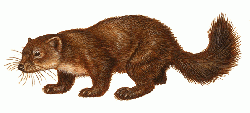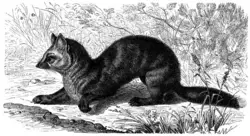Difference between revisions of "Sable" - New World Encyclopedia
Rick Swarts (talk | contribs) (added article from Wikipedia and credit/category tag) |
Rick Swarts (talk | contribs) |
||
| Line 1: | Line 1: | ||
| − | |||
| − | |||
{{Taxobox | {{Taxobox | ||
| name = Sable | | name = Sable | ||
Revision as of 19:42, 7 June 2008
| Sable | ||||||||||||||
|---|---|---|---|---|---|---|---|---|---|---|---|---|---|---|
 | ||||||||||||||
| Scientific classification | ||||||||||||||
| ||||||||||||||
| Martes zibellina Linnaeus, 1758 |
The sable (Martes zibellina) is a small carnivorous mammal, closely related to the martens. It inhabits forest environments primarily in Russia from the Ural Mountains throughout Siberia, in northern Mongolia and China and on Hokkaidō in Japan.[1] Its range in the wild originally extended through European Russia to Poland and Scandinavia.[2] It has historically been harvested for its highly valued fur, which remains a luxury good to this day. While hunting of wild animals is still common in Russia, most fur in the market is now commercially farmed.
Etymology
The name sable appears to be of Slavic origin and to have entered most Western European via the early medieval fur trade.[3] Thus the Russian and Polish sobol became the German Zobel, Dutch Sabel; the French zibelline Spanish cibelina, cebellina, Finnish soopeli and Mediaeval Latin zibellina derive from the Italian form. The English and Medieval Latin word sabellum comes from the Old French sable or saible.
The term has become a generic description for some black-furred animal breeds, such as sable cats or rabbits.
Physical Appearance
Males weigh 880-1800 grams and have body length between 380-560 mm, with relatively long tails between 90-120 mm. Males are somewhat larger than females (700-1560 grams, 350-510 mm).[4] Winter pelage is longer and thicker than their summer coat. Coloration varies in color from tan to black.[2] The fur is somewhat lighter ventrally and a patch of gray, white, or pale yellow fur on the throat is common. The finest, darkest fur is highly prized and referred to as "black diamond".
Behavior, habitat and ecology
Sables are diurnal predators, using their sense of smell and hearing to hunt for small prey. They have been observed to hide in their dens for days during periods such as snow storms, or when they are being hunted by humans. In the wild they are potentially vicious; although there are "domesticated" sables who have been described as playful, curious, and even "tame" (if taken from their mother at a young age). They are mostly terrestrial, hunting and constructing dens on the forest floor. They feed on chipmunks, squirrels, mice, small birds and fish. When primary sources are scarce they eat berries, vegetation, and pine nuts. When weather conditions are extreme they will store their prey in their den. Despite their small size, their sharp teeth and fierce demeanor discourage most predators.
History of exploitation and status
Sable fur has been a highly valued item in the fur trade since the early Middle Ages. Intensified hunting in Russia in the 19th and early 20th century caused a severe enough decline in numbers that a five year ban on hunting was instituted in 1935, followed by a winter-limited licensed hunt. These restrictions together with the development of sable farms have allowed to species to recolonize much of its former range and attain healthy numbers.[5] The collapse of the Soviet Union led to an increase of hunting and poaching in the 1990s, in part because wild caught Russian furs are considered the most luxurious and demand the highest prices on the international market.[6] Currently, the species has no special conservation status according to the IUCN, though the isolated Japanese subspecies M. zibellina brachyurus is listed as "data-deficient".[7]
Because of its great expense, sable fur is typically integrated into various clothes fashions: to decorate collars, sleeves, hems and hats (see, for example the shtreimel). The so-called Kolinsky sable-hair brushes used for watercolor or oil painting are not manufactured from sable hair, but from that of the siberian weasel.
ReferencesISBN links support NWE through referral fees
- ↑ Harrison, D. J. (editor) (2004). Martens and Fishers (Martes) in Human-Altered Environments: An International Perspective. Springer-Verlag. ISBN 0387225803.
- ↑ 2.0 2.1 Ognev, S. (1962). Mammals of Eastern Europe and Northern Asia. Jerusalem: Israel Program for Scientific Translations.
- ↑ “sable, n., etymology of” The Oxford English Dictionary. 2nd ed. 1989. OED Online. Oxford University Press. http://dictionary.oed.com/. Accessed: 11-2-2008
- ↑ Nowak first = R. M. (1999). Walker's Mammals of the World, 6th edition. Johns Hopkins University Press, 1936 pp.. ISBN 0-8018-5789-9.
- ↑ (1990) Grizimek's Encyclopedia of Mammals Volume 3. New York: McGraw-Hill.
- ↑ Tyler, P. E., "Behind the $100,000 Sable Coat, a Siberian Hunter", The New York Times, 2000-12-27.
- ↑ Martes zibellina – Lower Risk Least Concern. IUCN listing online. Accessed 11-2-2008]
External links
{{credit|Sable|215337983}]

